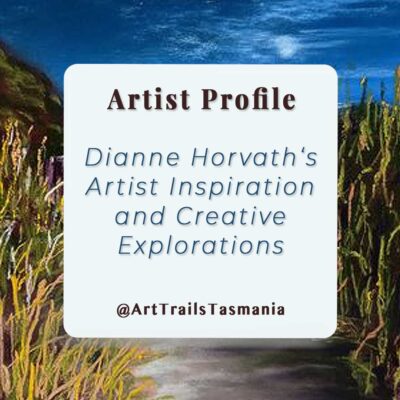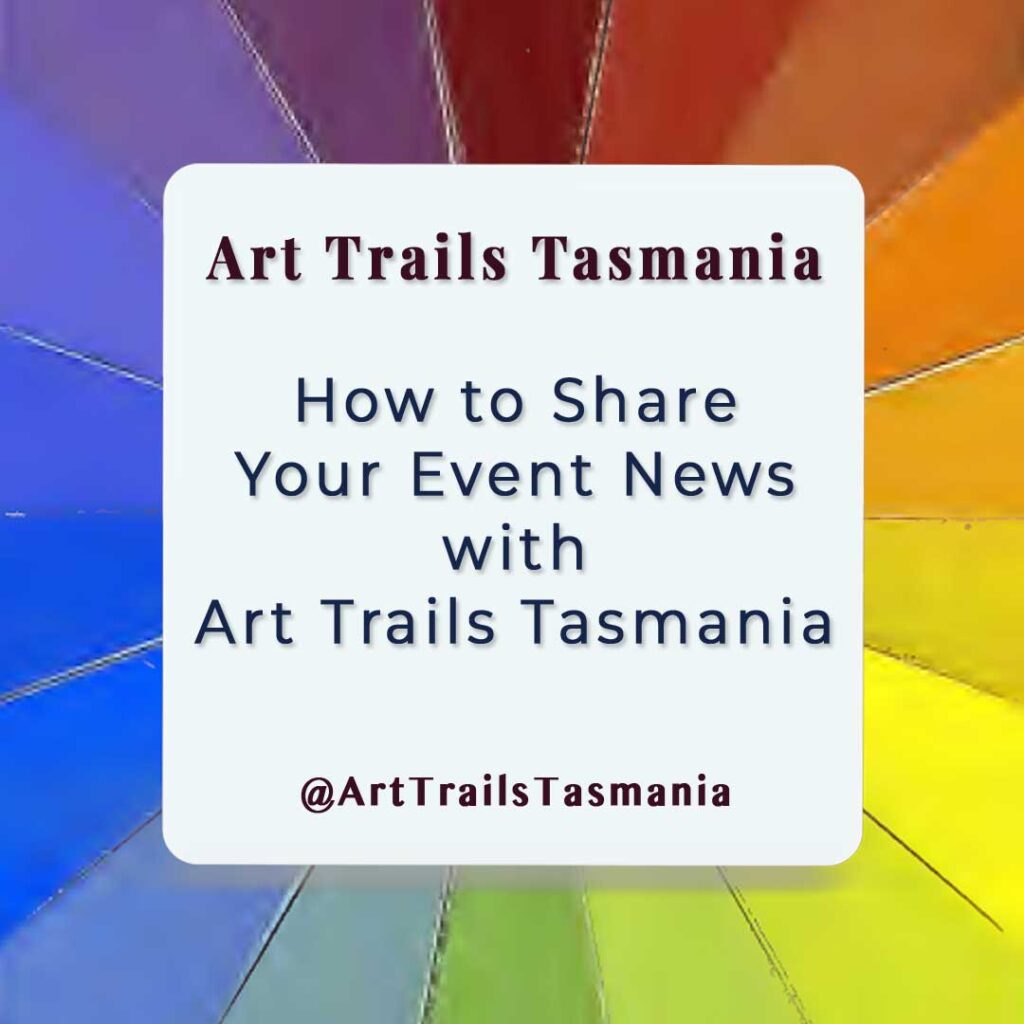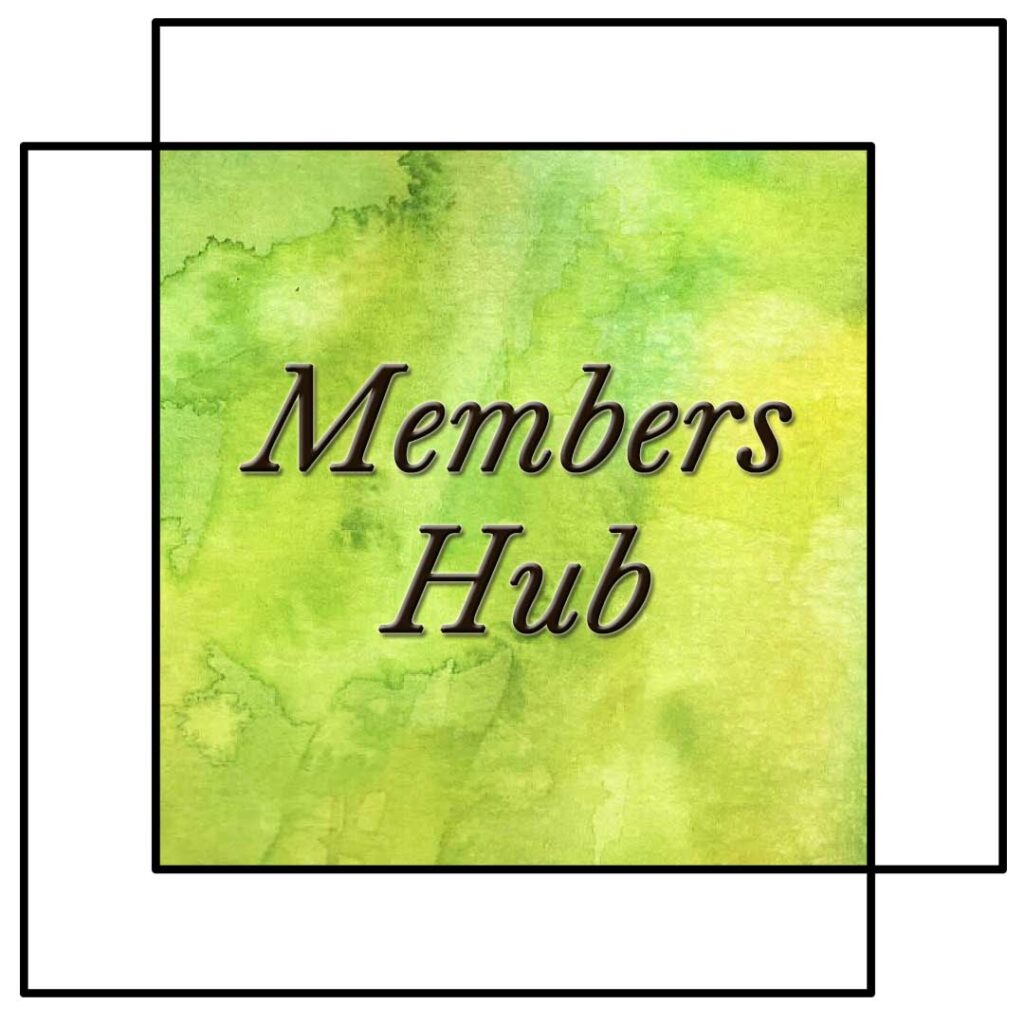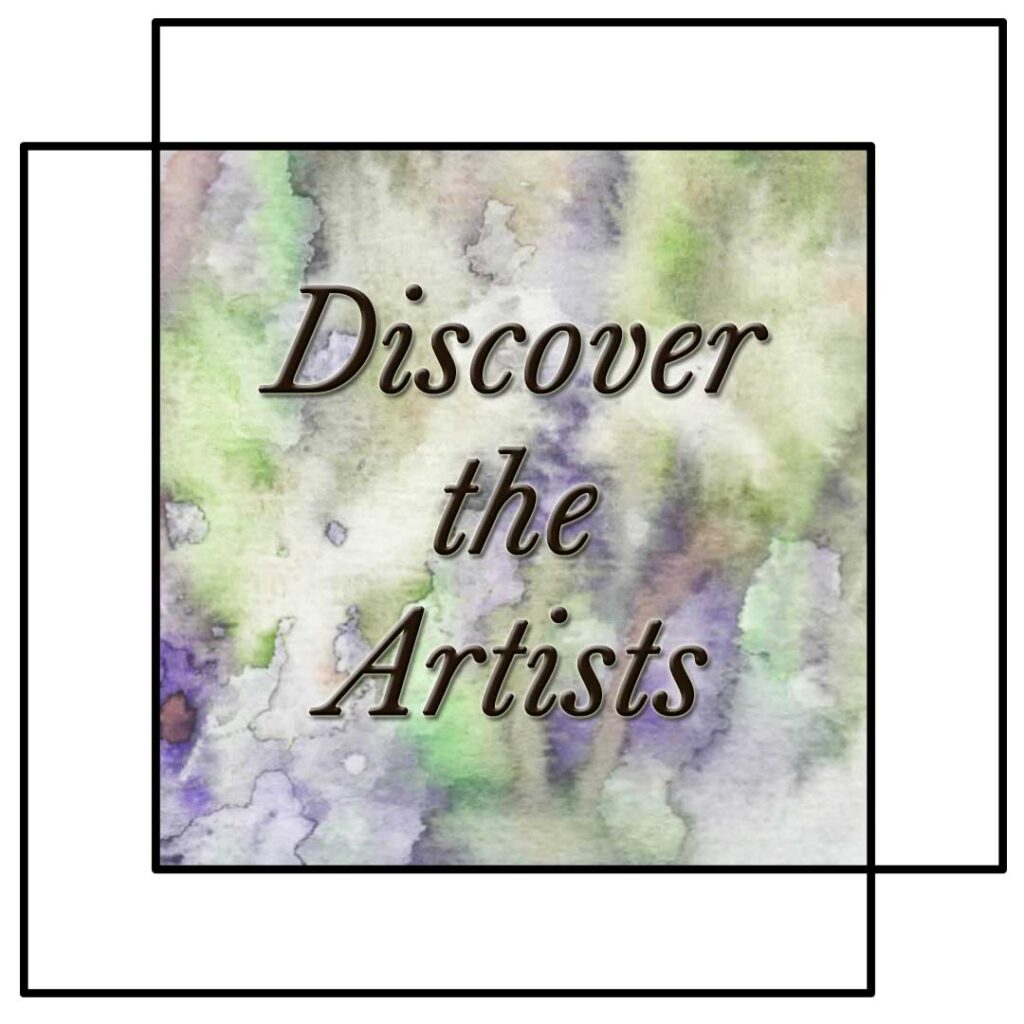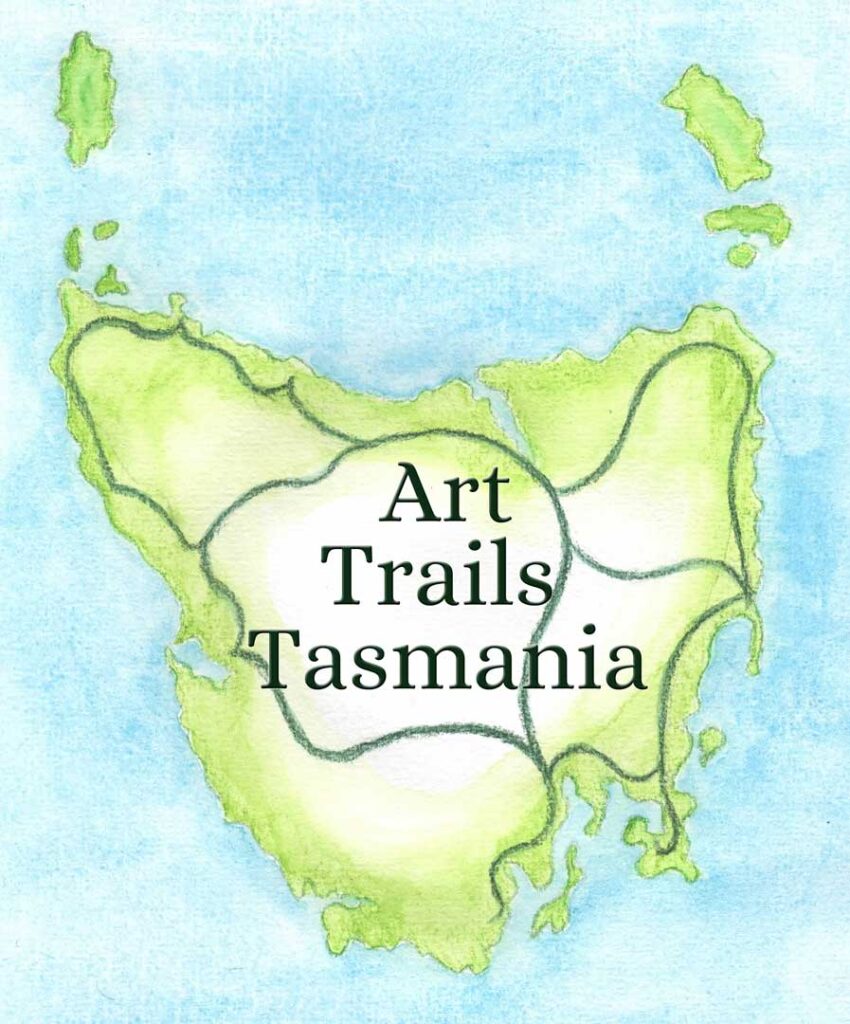Finding Joy in Nature Journal Sketching
Planning a nature journal sketching holiday in Tasmania can be an exciting and enriching experience. And your sketchbook will be a lasting treasure and reminder of your Tasmanian sketching adventures.
A Land of Inspiring Beauty
Tasmania offers a wide range of natural beauty, from rugged coastlines and pristine beaches to lush rainforests and unique wildlife and is a constant source of artistic inspiration as our artist members know.
So to help you make the most of this unique experience, here’s a step-by-step guide to help you plan your trip.
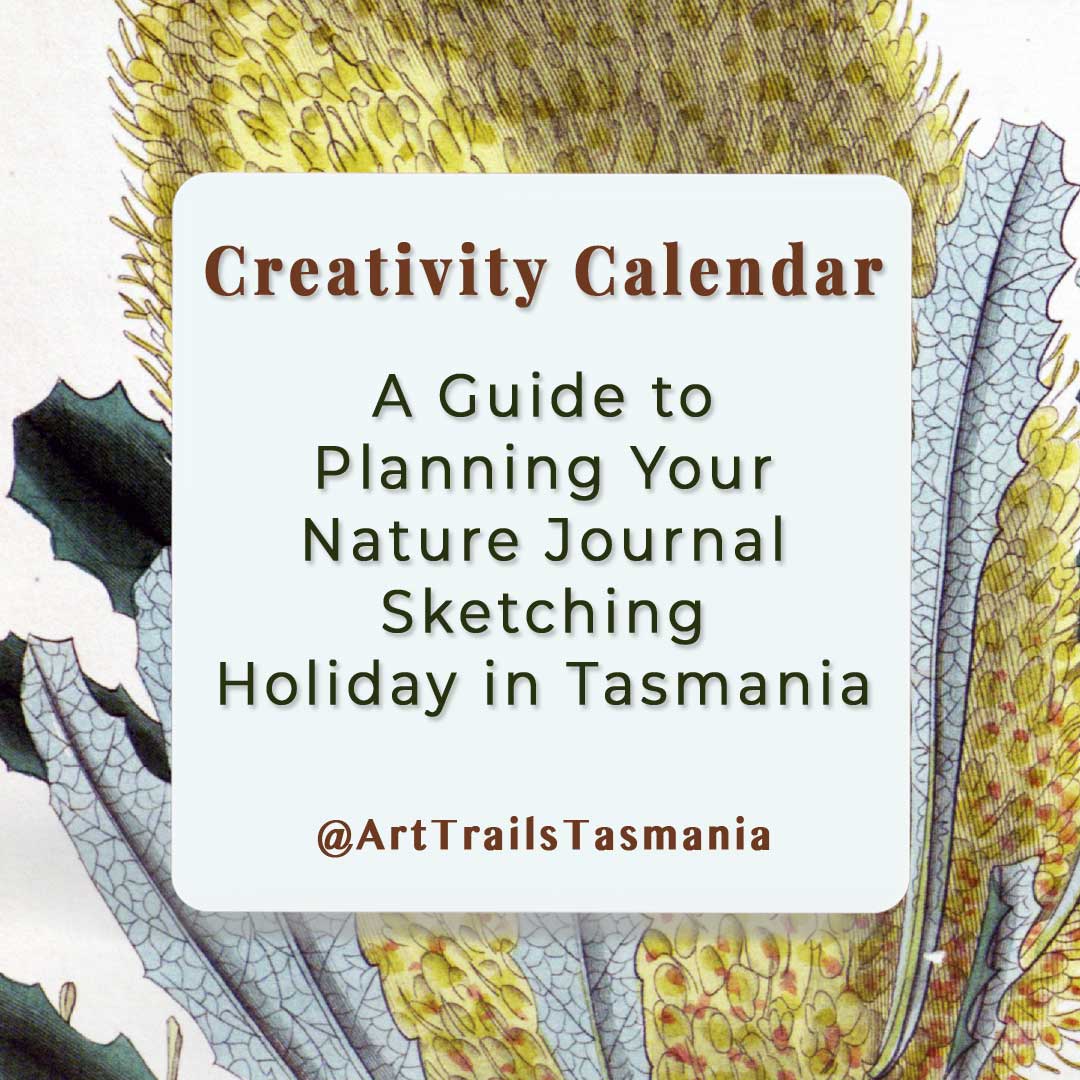
The Joy of a Nature Journal Sketching Holiday
To met the best holidays and escapes all involved my nature journal sketching kit. Some trips I fill up muliple sketchbooks, others I’m lucky to fit in just a few sketches.
To help you flourish with your own nature journal sketching adventures here are some tips:
1. Art Supplies and Sketching Kit
Pack your essential art supplies, including sketchbooks, pencils, watercolours, brushes, and any other materials you prefer. Ensure your art supplies are portable and suitable for outdoor sketching.
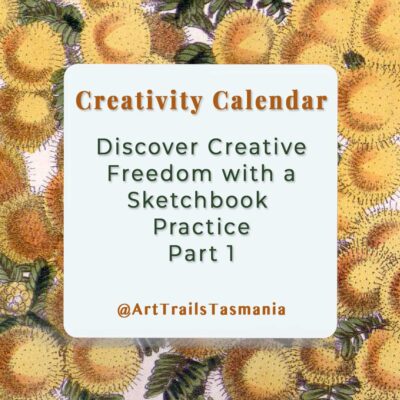
Discover Creative Freedom Through a Sketchbook Practice Part 1
Discover the joys of sketchbook practice in Part 1 of our series – explore materials, methods, and creative freedom for artists and crafters.
What Makes Up My Nature Sketching Kit
My sketching kit is small with a few brushes, pencils, an eraser and sharpener, an A5 sketchbook wrapped in a cloth that I use to wipe brushes on, and a travel tin of watercolour paints.
This all goes in my beloved sketching backpack so I can easily carry two bottles of drinking water, food, a “situpon” (this is designed so I can sit down without getting damp), a mini-first aid kit, my hiking camera, sunblock, and a few small useful supplies.
The contents of my sketching kit and backpack have evolved over the years and they do shift depending on the season and location. So when I am out sketching on a hike I’ll also have things to look after myself if I’m caught out overnight, such as a beanie and scarf, thermals, gloves, emergency thermal blanket, matches and lighter, head torch, personal locator beacon, and a dry bag for all of this (in case I fall in a creek or something, which has nearly happened when I got too carried away one time!).
I also like having a paper map of the area. Phones often don’t work in the more remote areas of Tasmania. I do head out by myself for sketching in places like the Tarkine so I need to seriously look after my personal safety.
Your safety kit will depend on where you go. So sketching platypus by the river in Deloraine doesn’t require the type of safety kit I take with me to Temma.
Art and Craft Shops for Your Sketching Holiday
There are a number of delightful galleries, cafes and art and craft supply shops through out Tasmania, with both Launceston and Hobart having large shops. Many towns will have smaller art and craft supply shops and I always find it fun to pop in and pick up something a little different to what the mainland chain art supply shops carry. Plus, it is putting money directly into small town creative businesses, which is always a joy to be part of.
2. Research Local Wildlife
Who and what do you want to sketch? Work up a list of your top animals and birds that you would like to sketch and what plants and locations you’d love to include.
Learn about the local flora and fauna to better understand what you might encounter during your journey. This knowledge will help you focus on what to sketch and observe in the wild.
Going to one of the numerous wildlife sanctuaries for a sketching visit is loads of fun. You get to learn about the various animals and birds that are being cared for as well as being able to easily observe them. Making sure you are there for feeding times is always a good option.
The wildlife sanctuaries play a key role in species protection in Tasmania, especially for the endangered animals such as the beautiful Tasmanian Devil.
You can also go on Platypus tours in towns like Deloraine so you can learn how to easily spot a platypus and enjoy a beautiful walk around the river.
Tasmania Wildlife Documentaries
Here is a collection of wonderful wildlife documentaries that you may enjoy as part of your research:
3. Document Your Journey in Your Sketchbook
Keep a detailed nature journal, noting the date, location, and a description of what you’ve sketched.
You can also add any observations, thoughts, or anecdotes about your experiences.
Remember that your sketchbook is for you, not to be exhibiting at the National Art Gallery.
What I love about my nature sketchbook is not how wonderful the sketches are, but how they immediately take me back to that moment and location, that sense of adventure and fun.
The Weather in Sketching
My sketches reflect the weather too, from being a mess because I was baking in the bright glaring February sun in 30+ degrees and being uncomfortable.
Sitting on a log in a rainforest and having misty rain making marks as it reactivated my watercolours.
Trying to capture the energy of really messy, wind torn waves while struggling to keep the sketchbook and supplies with me, rather than being strewn across the rocky beach below.
Straight Back to the Moment
Each of these sketches give me joy, they transport me immediately back into that moment. None of them are works of art.
I often sketch on beaches so will note the tide, time and weather alongside the location and date.
4. Enjoy the Creative Journey with Your Nature Sketching Journal
Remember that the journey is as important as the destination. Take your time to immerse yourself in the beauty of Tasmania and the act of sketching in nature.
To me, this is the most important part of it all, the delight in the journey.
Every time I have stopped to sketch I have enjoyed it.
Yes, I might be getting blown sideways, ducking for cover from a passing shower (rain is often passing, not staying put on an island), feeling insecure about doing justice to the vistas (which is more often the case for me), but I always find joy in having done it.
And I certainly love looking back through my journals and reliving the journey.
Learn from a Tasmanian Artist
Getting along to an artist led workshop or studio visit is a great way to learn from a talented and creative local. I also love exploring as many exhibitions as possible.

Denise Cox Finds Joy Through Expressive Colourful Art
It’s time to meet artist Denise Cox as she shares her joy and solace found through expressive and colourful art in her Artist Profile story with Art Trails Tasmania.
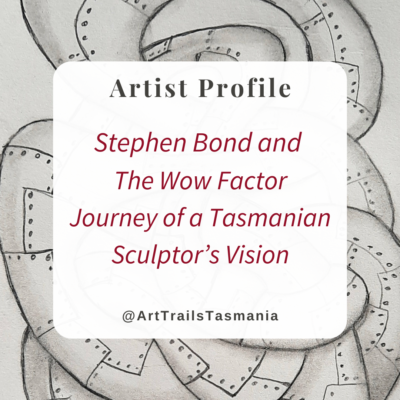
Stephen Bond’s Journey as a Sculptor
Meet Stephen Bond and explore his love for sculpture through out a varied creative life, from musician to sculptor to painter along a curvaceous journey.
You’re Invited to Join Our Supportive Community
The Practicalities of a Nature Journal Sketching Holiday
Now, let’s get down to the practical elements of this fabulous nature journal sketching holiday that you’re bringing into reality.
1. Set a Budget
Determine your budget for the trip, including expenses such as workshops, classes, art supplies, National Parks passes, flights, accommodation, food, and transportation.
Tasmania can be a bit remote with not many budget accommodation options in some areas, so consider these costs carefully.
2. Choose the Time of Year
Tasmania’s weather can be quite variable. A good time for a nature journal sketching holiday is during the summer (December to February) when the weather is warm and the landscapes are in full bloom.
However, if you prefer fewer crowds and milder temperatures, consider visiting during the shoulder seasons of spring (September to November) or autumn (March to May).
Some areas and roads are closed in winter due to the conditions.
3. Plan Your Itinerary
Research the specific locations and natural sites you want to visit for sketching.
Some popular spots include Cradle Mountain, Freycinet National Park, Maria Island, the Tamar Valley Wetlands, George Town, The Great Western Tiers, the Bay of Fires, Mount Field National Park, and the Tarkine Wilderness.
Create an itinerary that includes time for sketching, hiking, creative workshops, exhibitions, retreats and relaxation.
Give yourself time to do the key things that you want to explore. Only a few of us get to do solo travel and do exactly what we want every day. Most need to consider their travel companion/s and what is also important to them. So make sure you find a happy balance. If you find yourself in Launceston and Hobart you can still do lots of nature sketching, from exhibitions at the Tasmanian Museum and Art Gallery, the beautiful gardens and even some urban sketching of gorgeous architecture, which both cities have in abundance.
When planning your itinerary, be sure to give yourself time in each place. Many make the mistake of spending much of their trip driving from place to place for just a one night stay. Be kind to yourself and enjoy the journey by spending at least three nights at each location. You may even be able to get better accommodation pricing for doing so.
The south of Tasmania, especially around Hobart, is much busier than the north of Tasmania. Both are equally beautiful, abundant in great food and locations and interesting.
4. Accommodation
Book accommodations in advance. You can choose from a variety of options, including motels, hotels, B&B’s, farm stays, hostels, campsites, or even eco-lodges to immerse yourself in nature. Staying in National Park cabins can be a unique experience.
Often the accommodation options during the peak summer season can be booked out early, including camping sites, and there is also a premium pricing cost.
Just as with everywhere, booking accommodation via the accommodation websites like trivago, stayz etc is usually more expensive than calling the motel etc yourself and making the booking because of the commission they charge the accommodation business.
Join Art Trails Tasmania
5. Transportation
If you’re planning to explore multiple regions of Tasmania, renting a car or camper van is often the most convenient option.
Make sure to have a valid driver’s license and book your rental vehicle well ahead of time. Alternatively, consider guided tours for specific areas. These can be really fun and there are a number of options available.
If you are wanting to bring your own car on the Spirit of Tasmania you’ll need to book months in advance.
The Spirit of Tasmania significantly increases its fares closer to the desired sailing date.
If you are wanting to bring your caravan you will probably need to book at least 12-18 months out.
6. Safety Precautions
Familiarise yourself with safety guidelines and advice specific to the locations you plan to visit.
Be sure to have at least two reusable water bottles per person as drinking water is often not available along walking tracks. If going to the north east region take at least five litres of water in reusable drinking bottles as there is a shortage of drinking water.
Leave No Trace
Follow the “Leave No Trace” principles to minimise your impact on the environment. Plus, pick up rubbish that you find along the way and put it in a bin. Simply carrying a bag for collecting any rubbish can make the world of difference (it is an easier way to carry those single serve plastic bottles and cans that wash up along the waterways and do so much damage to so many creatures).
Winding Tasmanian Roads
Many of the roads in Tasmania are winding around hills and cliffs, and while they often have spectacular views it is straight-out dangerous and irresponsible to stop your vehicle in the middle of the road (because there are no safe shoulders to pull over onto) to take photographs. Obviously, this sort of stupid behaviour is illegal and it puts your life and any other road user’s life at serious risk.
Only pull over where it is safe to and your vehicle is entirely off the road.
Save Yourself from Google Maps & Co Disasters
Do NOT trust the directions of Google Maps, Apple Maps, TomTom etc as these navigation tools regularly lead drivers down narrow dirt roads that have dead-ends, very poorly maintained dirt roads that are used by large logging trucks that do not like tourist vehicles, or local dirt roads that are really only 1.5 car widths and are actually two way and don’t have shoulders. Just don’t do it. These navigation providers have not done their research and don’t care what happens to you.
Get yourself a paper map and enjoy being about to see what is around you and get their safely. These also make great souvenirs of your trip and are perfect for planning your next Tasmanian adventure.
7. Weather Preparedness
Tasmania’s weather can be unpredictable. Pack appropriate clothing, including layers, rain gear, and warm clothing, even if you’re visiting during the summer. Packing a light woollen jumper, wind and rain proof jacket, long pants and even a scarf and beanie is a simple solution.
Being prepared like this will make your sketching holiday far more enjoyable.
And in the cooler months, be sure to take shorts and t-shirts as well because there can be stunningly warm days through autumn and spring.
Hiking and Nature Journal Sketching
If you are hiking you will find proper hiking pants like the Kuhl Splash Rollups to be far more versatile and useful than jeans. Once wet, it can feel like jeans take ages to dry and be comfortable again, whereas hiking pants are designed to dry quickly.
Thigh pockets are also very useful (sadly, not many women’s hiking pants designs have handy thigh pockets, but the Kuhl Splash Rollups are designed for the more curvy lady who enjoys getting out and about for her adventures, are practical and comfortable).
I’ve learnt to also have rain protection for my sketching backpack and day backpack. Many Blackwolf backpacks come with inbuilt rain jackets for the bag. For my Osprey sketching kit backpack I have a clear plastic reusable poncho that goes over me and my small 9L backpack, it has come in handy for passing rain squalls. Osprey does sell their own range of detached rain coats for their bags but they are quite expensive and they don’t pack away neatly or easily.
Also make sure you take and use a hat and sunblock as it is easier to get sunburnt in Tasmania.

15 Tips for Artists to Master Redbubble to Boost Sales & Visibility
Here’s 15 ways how to to Flourish on Redbubble: Create, Sell, Connect! In this latest Skills Sharing story by Art Trails Tasmania
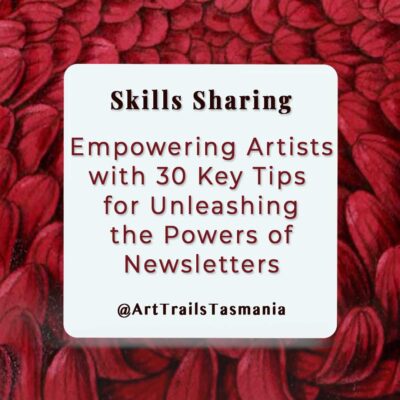
Empowering Artists with 30 Key Tips for Unleashing the Powers of Newsletters
Unlocking Success with 30 Essential Insights for Artists on Maximising Email Marketing and Newsletter Power.

15 Tips for Selling Success and Thriving on Bluethumb Part 1
Discover 15 tips for financial success and flourishing on Bluethumb, the vibrant online marketplace connecting artists with art buyers in this two part guide by Art Trails Tasmania.
8. Permits and Regulations
Check if any permits are required for the specific places you plan to visit, especially if you intend to camp or hike in National Parks. Ensure you’re aware of and comply with all local regulations.
It is easy to buy your National Parks pass online, at Service Tasmania shop fronts and on the Spirit of Tasmania.
Making Use of a Nature Sketching Journal
We use our sketchbooks for all manner of purposes and practices. From planning out full sized studio works to capturing detailed botanical illustration notes to rapid wildlife sketches that record more about the movement of a delightful creature than a resolved, finished work.
A nature journal sketching holiday in Tasmania offers a unique opportunity to connect with the natural world and develop your artistic skills while exploring one of Australia’s most beautiful and diverse regions.
Allow yourself to enjoy the experience and take home a unique Tasmanian treasure that you have crafted for yourself that is full of memories of adventure and wonder.
Discover our Artist members…
Meet Jane Seychell: Capturing the Realism of a Moment in Time
A Love for Nature Shines Through Jane Seychell's Art My work captures the realism of a moment in time. I use colour pencils to blend hues and bring my art to life. My subjects range from childhood memories to the vibrant flora around me. A love for nature shines...
Crafting Magical Worlds and Nature’s Wonders with Laurinda Brooker
Living a Creative Life Constantly Inspired by Nature When it comes to my more fantasy inspired work, I find joy in creating a tiny slice of a magical world. I love creating a small world on paper or from clay, and imaging the beings that might inhabit it. In regard to...
Dianne Horvath’s Artist Inspiration and Creative Explorations
Meet Pastel Artist Dianne Horvath I enjoy being around other artists and finding inspiration from their work. The Tasmanian landscape inspires me in so many different ways. The variety of colours, atmospheres, animal life and the diverse artistic talent here. I...
Read What Our Members Say About Belonging
Join the growing, supportive artists community today and have your Artist story told here.
Belinda is doing a great job creating a professional looking artist hub online. Check out the profile I posted recently to see how well she does them. To all my artist friends let’s help make this THE go to place to discover local artists.
You won’t regret joining Art Trails Tasmania . It’s a welcoming community for creatives at any career stage.Becoming an Art Trails Tasmania member wasn’t a hard decision for me to make as it’s such a wealth of knowledge and support.Being member provides a quality way to showcase your creative endeavours and it’s quickly growing in reach.
We operate a home based picture framing business and recently joined Art Trails Tasmania as a means to giving us exposure to the wider artist community. We have almost immediately seen increase in activity thru our online sites, which I am certain will lead to more opportunities to grow our business.




